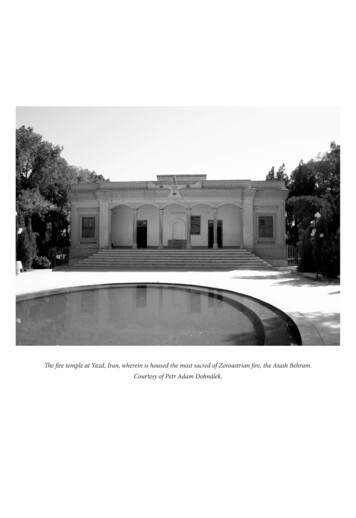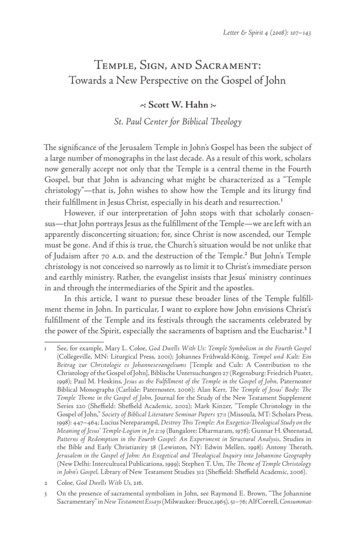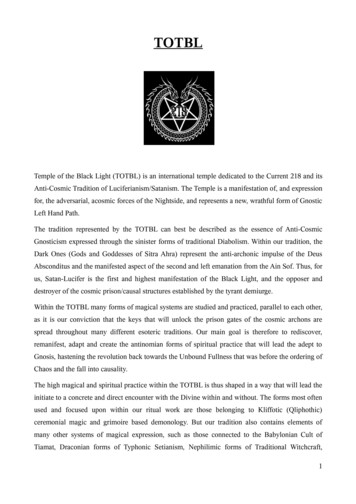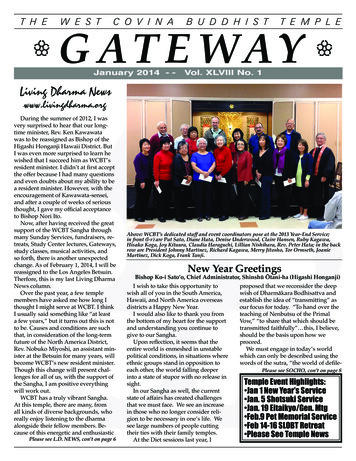
Transcription
The fire temple at Yazd, Iran, wherein is housed the most sacred of Zoroastrian fire, the Atash Behram.Courtesy of Petr Adam Dohnálek.
Chapter 10ZoroastrianismZoroastrians and members of The Church of Jesus Christof Latter-day Saints both believe in a strong sense of divinecontrol which will end in victory over an evil personage.Zoroastrianism is an ancient faith which arose in Persia (contemporary Iran). The number of Zoroastrians in the worldtoday is not clear. It was held in the twentieth century thatthere were only 100,000 to 150,000, but recent studies have called thatestimate into question, and the site we have been using for populations of the various religions now says the number of Zoroastriansmay be around 2.6 million.1 This number seems much too high,however. The Zoroastrian population is not the only thing difficultto assess. Zoroastrian history and theology are also obscure at timesbecause sacred texts were destroyed by invading peoples such as theGreeks under Alexander the Great, and the Muslims. Thus, as weseek to understand Zoroastrian origins and history, our knowledgeis limited by the loss of many of these sacred texts. Given that limitation, we will still be able to see the strength and power of this historicfaith. Despite its small size, Zoroastrianism is important not only forits own beliefs but also because of its impact on Judaism, Christianity,
Light &Truthand Islam, all of which were in contact with the faith at various pointsin their histories. Much of what follows is based on S. A. Nigosian’sbook The Zoroastrian Faith: Tradition and Modern Research.OriginsScripturesThe scriptures of Zoroastrianism are the major source of knowledge for both the history and theology of the faith. Consequently, wewill begin with them. Their overall name is the Avesta, which has twoprimary parts. The first part includes a portion known as the Gathas,which may date back to Zoroaster (or Zarathustra), the founder ofthe faith. In addition, there is much literature that is used in worship,as well as writings that deal with the major theological themes of thefaith. The second part contains material for use in personal worship.The primary difficulty with the Avesta is that it arose over a periodof more than a thousand years, thereby making it hard to determinewhat Zoroaster himself believed versus what later believers of thefaith held. The existing texts, however, are our principal source forthe content of the Zoroastrian faith.FounderThe founder of Zoroastrianism was a man named Zoroaster(Latin, Greek) or Zarathustra (Avestan). When he lived is debated.Nigosian states that there are various streams of thought. One is thathe lived between 1500 and 1000 BCE. Another group of scholarsplaces Zoroaster between 900 and 400 BCE. Clearly, there is noagreement as to when he lived, and Nigosian suggests that with allthe conflicting opinions, the traditional dating of the sixth centuryBCE is as acceptable as any other.2Nigosian stresses that very little is known with certainty aboutZoroaster.3 We do know that he was born into a religious environment that was similar to the Aryan religion we have already encountered in the Hindu chapter. Not only did the Aryans migrate intoIndia, but they also moved into Persia and Greece and finally as farnorth as the Scandinavian countries. The Aryan religious environment was rich with a variety of gods, and consequently, so was that ofthe Persians. Apparently, Zoroaster prepared to become a priest, but190
Zoroastrianismaround age thirty he began to have visions and to develop a deeplypersonal relationship with the god Ahura Mazda (Wise Lord). Outof those experiences he gained a desire to spread his faith but foundthis a very difficult task. He finally found a patron in King Vishtaspa,who accepted the faith, which then spread through his kingdom.Some authors suggest that Zoroaster participated in two wars todefend Zoroastrianism and died in the second while officiating at thefire altar, but this is difficult to confirm.4 The above account marksthe broad outlines of Zoroaster’s life.Latter-day Saints will see some interesting points of contactbetween Zoroaster and Joseph Smith. Both men began their work inan established religious environment, and both had visionary experiences that led them to challenge the existing religion. Zoroastrianssee Zoroaster’s death as a martyrdom, and certainly Latter-daySaints view Joseph’s death in precisely that way. Both of these greatreligious leaders seem to have sealed their testimonies with the lossof their lives.Zoroastrianism became the religion of Persia under theAchaemenid dynasty (559–330 BCE), with priests known as magi,and was practiced by such great rulers as Cyrus the Great, Xerxes,and others. Greek culture influenced Persia with the coming ofAlexander the Great in 331 BCE, and this was followed by the influence of Parthians from eastern Persia, who ruled from 250 BCE to226 CE. The Parthians were eventually defeated by the Sassanidsof Old Persia, who reigned from 226 to 651 CE themselves, finallybeing defeated by Muslim armies. Zoroastrianism grew and wasmodified through these periods of political change.5 Today the twolargest communities of Zoroastrians are found in Iran, the land ofits origins, and in India, where Zoroastrians are known as Parsis(Persians).Zoroastrian PrinciplesZoroaster’s TheologyOn the basis of his visions and relationship with Ahura Mazda,Zoroaster condemned the Persian deities that were being worshiped, defining them as evil spirits and followers of the Lie.Followers of Ahura Mazda, the supreme God, were to follow Truth,191
Light &Truthof which Ahura Mazda was the father. It was Ahura Mazda who wasthe supreme being, the creator of all things, the bringer of all goodand life. He was also the father of Good Mind and Right Mind. Itis unclear whether Zoroaster viewed these as attributes of AhuraMazda which could be conveyed to his followers or as beings likeangels. Ritually, Zoroaster adopted fire as the representation ofAhura Mazda and Truth.The heart of Zoroaster’s thought focused on the freedom of choicethat human beings must exercise. The soul was a battlefield betweengood, represented by Ahura Mazda, and evil, reflected in AngraMainyu, who was coeternal with Ahura Mazda but not coequal.Humans were charged with the responsibility of making moralchoices between good and evil, but they had a natural affinity for thegood. At the end of this life, they would be judged at the “bridge of thejudge,” where the good would be sent to heaven and the evil to hell.In Zoroaster’s mind, there was no doubt at the cosmic level about theoutcome of the battle between good and evil. Good, Ahura Mazda,would be the winner over a much weaker foe. Ultimately, there wouldbe two ages—the present age, in which the struggle between goodand evil was played out in the human heart, and the future age, inwhich Ahura Mazda would reign alone.6The above concepts resonate with Latter-day Saints. For them, freeagency is an eternal principle which cannot be abrogated. Humanbeings use their free will to choose between right and wrong and tostand on the side of their Heavenly Father, his Son Jesus Christ, andthe Holy Ghost, who represent that which is good. In addition, Latterday Saints hold that human beings are pure upon entry into thisearthly life. They are not contaminated with anything like original sin,and until they reach an age of accountability, they remain blamelessbefore God. In contrast to Heavenly Father, Jesus, and the Holy Ghoststands Satan, who is constantly working to draw humans into the darkand evil side of life. He has, however, been defeated in Jesus’ life, suffering, death, and Resurrection. So Satan’s end is sure, but he is like adragon which has been beheaded yet which continues to thrash aboutand still does great damage. In neither Zoroaster’s nor Latter-day Saintthought is evil equal to God. Rather, it is something that exists becauseGod permits it to exist for a time but is fully defeated in the end.192
ZoroastrianismDevelopments after ZoroasterDuring Zoroaster’s life, it seems that Ahura Mazda was clearlyviewed as the supreme deity in the universe. Although he wasopposed by the evil force, Angra Mainyu, there was no question ofequality between them. However, with the rise of the Achaemeniddynasty mentioned above, there were changes injected into the religion, the most obvious being the reintegration of the old Aryan godsthat Zoroaster had so clearly rejected. Thus, the magi, or priests, wereserving other gods along with Ahura Mazda. This revised religionbecame that of the Sassanids. During their time, there were aboutforty-five angels or subdeities who also were being worshiped.One of the principal developments was that the doctrine of evilwas augmented. Angra Mainyu was no longer a relatively weak entityopposing Ahura Mazda but became the archenemy of humanity whowas almost coequal with Ahura Mazda. He also became subordinateto another demonic figure who created all evil things.Among Latter-day Saints, Satan is clearly an evil force opposed tothe Father, the Son, and the Holy Ghost. In no way, however, is thereany question of coequality, and Satan certainly did not participatein creation. Moses 4:23–25 makes it clear that even the thorns andthistles which make human life hard are part of God’s creation, notSatan’s work. The Father and the Son organize all life and nonlife.On the Good SideAhura Mazda. According to Nigosian, Ahura Mazda “is self-created, omniscient, omnipresent, holy, invisible, and beyond humanconceptualization.”7 He is the supreme ruler and is all-knowing,so nothing is hidden from him. He created both the heavenly andearthly realms and gives material and spiritual blessings to those whofollow him. He guides humankind, and consequently, those who seekthe good need to follow his guidance. He also forgives those whomake mistakes, and in the end he will redeem even the wicked. It wasthese secrets of creation, life, and death that Ahura Mazda revealedto Zoroaster.8 Everything that is good is a creation of Ahura Mazda.He creates nothing that is evil or disgusting. Ahura Mazda works inthe universe through Good Spirit, which does not seem to have anexistence apart from Ahura Mazda.193
Light &TruthHoly Immortals. Besides the material realm, Ahura Mazda alsocreated six spiritual powers or spiritual beings—Good Mind, BestRighteousness, Desirable Kingdom, Holy Devotion, Health, andImmortality. These are the Holy Immortals. Nigosian states, “AhuraMazda created the [Holy Immortals] to aid him in his work. . . . Eachhas a specific character and an assigned sphere to act on behalf, or asagent, of Ahura Mazda. . . . Each [Holy Immortal] fulfills a twofoldfunction: on the spiritual side each represents, or personifies, somespecific virtue; and on the physical side each presides over somematerial object as its guardian spirit.”9Hence Good Thought, who is chief of the Immortals, personifiesAhura Mazda’s thought and wisdom and will establish the kingdom ofGod when directed to do so by Ahura Mazda. Interestingly, marriedpersons possess more of Good Thought than those who live a celibatelife. In the physical realm, Good Thought guards the animals.Best Righteousness personifies God’s law and moral order whileguarding fire. Desirable Kingdom personifies the royal powers ofGod, such as might, majesty, and sovereignty. In the physical realm,he guards the sky, protects warriors, and presides over metals. HolyDevotion is female and personifies immovable faith. She also guardsthe earth and protects herdsmen and farmers. Health and Immortalitystand together, since both are the reward for a righteous life. Both arefeminine. They are to bring help, pleasure, and joy to those who follow Ahura Mazda. At the physical level, Health guards water, andImmortality guards vegetation. In addition to the Immortals, thereare lesser divine beings. All six of the Immortals and the lesser divinities are worshiped along with Ahura Mazda, thus removing any senseof pure monotheism from current Zoroastrianism.10In Latter-day Saint thought, there is nothing equivalent to theHoly Immortals or the lesser divinities. The Father, the Son, and theHoly Ghost compose the Godhead, but there are no secondary deities. Messengers (angels) may be sent from heaven to earth, but theseare either spirits waiting to assume an earthly existence or personswho have already lived on the earth. There is no sense in Latter-daySaint thought of beings created solely to serve in the heavenly court.Fravashi and the human being. “[Fravashi] are the celestialoriginals of terrestrial duplicates—the double of every heavenly194
Zoroastrianismand earthly being or element.”11 They lived with Ahura Mazda wellprior to the creation of anything. All persons, the natural world,and even the elements—that is, every entity created by AhuraMazda—have their own Fravashi. The Fravashi provides guidanceand help to persons. It functions much like a guardian angel. “ThisFravashi is the higher double of the individual and acts as a divinevoice, a guardian spirit, and a true guiding friend.”12 Even when aperson sins, the Fravashi remains pure and unsullied, and thoughit warns a person, that individual alone is responsible for his or heractions. At a person’s death, their Fravashi returns to the presenceof Ahura Mazda and lives as the representative of the person orentity of which it is the archetype. It is not equivalent to the soul orthe body which make up an earthly person.On the Evil SideAhriman. There is a dark side to the force in Zoroastrianism.Evil, or Ahriman, has an independent existence, is uncreated, standsagainst Ahura Mazda, and in later Zoroastrianism is almost equallypowerful. For every good thing created by Ahura Mazda, Ahrimancreates the opposite. Thus nothing evil arises from Ahura Mazda,and nothing good arises from Ahriman. Therefore, Ahura Mazda iswholly good and Ahriman is wholly evil. Consequently, “the phenomenal world consists of pairs of conflicting opposites: light/dark,truth/falsehood, health/sickness, rain/drought, pure/impure, goodcreatures/noxious creatures, life/death, heaven/hell.”13 Snakes, frogs,scorpions, lizards, and any other obnoxious creature are the products of Ahriman’s work. He also creates the thistles and weeds thatmake human life miserable. His whole goal is to create pain and suffering and misery in the world. The one thing that Ahriman is not,however, is all knowing. Therefore, he does not know that he andhis work are doomed and will be overcome by Ahura Mazda. Theremay be some parallel to this in Moses 4:6 regarding Satan, wherewe read, “And Satan put it into the heart of the serpent, (for he haddrawn away many after him,) and he sought also to beguile Eve, forhe knew not the mind of God, wherefore he sought to destroy theworld” (emphasis added). Even though Latter-day Saints believe thatSatan had once stood in the presence of God, this text would suggest195
Light &Truththat he never understood the Father’s intent in creating the worldand sending people into it.Angra Mainyu. The opposite of Good Spirit, through which AhuraMazda works, is now Angra Mainyu (Hostile Spirit or Evil Spirit), thedemon of all demons, through which Ahriman works his evil in theworld, be it in the moral realm or in the natural world.14 He standsin absolute opposition to Good Spirit. He is the cause of all sufferingand pain. He is surrounded by six “arch demons,” which are opposites of the six good spirits. They drive away anything that is good, beit good thoughts, desires, hopes, or dreams. Their tools are lies andcounterfeits of that which is good. They try to draw humans to makechoices for evil rather than good, and they are assisted by a swarm oflesser demons at the earthly level. There is a cosmic combat betweenAhura Mazda and Ahriman that works itself out at the level of thecreated world and in the heart of every human, since all have to makechoices between good and evil. Humans will be judged in the end byhow good their thoughts, words, and deeds were during their lives. Inthe end, all evil will be destroyed.There is much here upon which Latter-day Saints may reflect.They certainly see Satan and his minions at work in every cornerof this world, seeking to bring misery and suffering to the humanfamily. As in Zoroastrianism, it is incumbent upon individuals tochoose between good and evil and not to succumb to the enticingsof these demonic forces. It also calls to mind 1 Nephi 13 and 14,which deal with the great and abominable church. In 1 Nephi 14, wesee a cosmic conflict between the church of God and the church ofSatan, there being only two “churches.” This is comparable to theabove noted cosmic combat between Ahura Mazda and Ahriman.Similarly, this cosmic conflict spills over onto the earth, where itmanifests itself as the great and abominable church. The marks ofthis church are materialism, sensuality, and opposition to the churchof God. These marks are to be found in all human organizations toone degree or another. They are even found among members of TheChurch of Jesus Christ of Latter-day Saints, where too many members are drawn to the materialism and sensuality of the world in theirsearches for monetary gain, approval of the world, and pornographictitillation. The difference between Zoroastrian and Latter-day Saint196
Zoroastrianismthought, however, is that in Latter-day Saint theology, for all theapparent power of evil, its source is not equal in power to God andhis power. It exists in the world only by God’s permission, and Goduses it to shape and hone the Saints as they choose the right.After DeathWhen persons die, their souls stay near the body for three days,during which they contemplate all their thoughts, words, and deeds—both the good and the bad. Those who were good are comforted byangels, and those who were bad are assaulted by demons. On thefourth day, souls move to Chinvat Bridge (Bridge of Judgment),which spans hell and leads to paradise. There, souls are judged bythree deities and then sentenced to either hell or paradise.15 Thesouls that are good are met by a beautiful maiden who representstheir good consciences, and they move easily across the Bridge ofJudgment to paradise to await the general Resurrection. Those soulswho were evil will be met by an ugly hag personifying their bad consciences, who leads them to the bridge, which rotates to present aknifelike edge from which they fall into hell, there to be tormenteduntil the Resurrection. For those who have an exact balance betweentheir good and evil deeds, there is an intermediate place for themuntil the Resurrection. There is no suffering here except that associated with seasonal temperature changes.16For Latter-day Saints, life after death includes a variety of gradations immediately after death, as it does in Zoroastrianism. Thosepersons who attained the age of accountability and who followedChrist and received the saving ordinances of the gospel will enterparadise to await the Resurrection. From there they will be calledto teach the gospel to persons in other areas of the spirit world whohave not yet had the opportunity to know Jesus or receive savingordinances under priesthood authority (D&C 138). This region ofthe spirit world seems to have a spectrum of people within it. Thereis a region of the spirit world known as hell, where those who die intheir wickedness are sent, but they are not immune to the missionary efforts of those in paradise. Most of the spirit world might becomparable to the intermediate place in Zoroastrian thought or topurgatory in Roman Catholic theology.197
Light &TruthThe Last Days—Three Thousand YearsZoroastrians believe they are living in the final times of thisworld. The final three thousand years of the earth’s existence beganat the time of Zoroaster’s birth. At the end of each successive thousand years, a savior figure will be born to progressively elevate thehuman population. Thus there are three savior figures, each beinga son of Zoroaster, since some of his seed was preserved in a lakein Persia in which a maiden would bathe every millennium andbecome impregnated. At the end of the third thousand-year period,the human family will have overcome all evil, and those living atthe time of the Resurrection will join those who are already resurrected.17 Both heaven and hell have levels, or degrees. There are threedegrees in the heavenly realm prior to the Resurrection in the regionsof the stars, the moon, and the sun. The good soul passes successivelythrough these until reaching the highest heaven.At first blush, the immediate reaction of the Latter-day Saint to thislast assertion concerning three levels in heaven is to see a close parallelto their own thought, especially with the tie to the stars, moon, and sun.But if we look more closely, we see that the correlation is not as close asit seems. While there are three levels of heaven in Zoroastrianism, theyexist before the Resurrection, while Latter-day Saints talk about threedegrees following the Resurrection and Final Judgment. Secondly, thegood soul passes through all three levels in Zoroastrianism to arrive atthe highest level, while among Latter-day Saints the basic assumptionis that there is not progression between the degrees of glory.We also see in Zoroastrianism a sense that they are now livingin the “last days.” This is now the third thousand-year period, running roughly from about 1500 CE to 2500 CE, if we assume thatZoroaster was born in the sixth century BCE. However, it seems thatZoroastrians believe that when the end does come, humanity will haveprogressed to a level approaching perfection, whereas for Latter-daySaints, humanity will have reached a state of warfare and degenerationprior to Christ’s Second Coming and the Resurrection of the dead.ResurrectionOn the day of Resurrection, the earth, the fire, and the sea willall give up their dead, and bodies and souls will be reunited. For198
Zoroastrianismthree days, evil persons will endure extreme punishment in hell,while the good individuals will spend three days in bliss. Thosein the intermediate realm will continue in their neutral way. Thena river of burning liquid metal will engulf all the resurrected. Tothose who were righteous, it will feel like warm milk, but to thewicked it will be excruciatingly painful according to their sinfulness until all evil is burned out of them. Ahriman and his followerseither will be thrown by resurrected beings into outer darkness tohide forever,18 or there will be a huge final battle in which AhuraMazda’s followers will be triumphant and Ahriman and his followers destroyed.19 After this, all people—the good and the newlyrefined ones with their evil now gone—will live in a newly createduniverse. Adults will remain forever forty years old, and childrenwill be forever fifteen. In other words, Zoroastrians hold a doctrineof universal salvation.For Latter-day Saints, the Resurrection is not a one-time event buta process. Some persons were raised at the time of Jesus’ Resurrection,and others have been already raised, like John the Baptist, Peter,James, and Moroni, all of whom appeared to Joseph Smith. At thetime of Jesus’ Second Coming, the righteous will join Christ, andthose dead who are either celestial or terrestrial in nature will beraised.20 During the Millennium following Jesus’ return, people willdie and be instantly resurrected. At the end of the thousand years,the Resurrection of the unjust will take place, at which time the FinalJudgment will occur and persons will be placed in one of the threedegrees of glory. In one sense, salvation is almost universal, if by thatwe mean that few will go to outer darkness and not receive a degree ofglory. If, on the other hand, we mean that salvation is exaltation in thecelestial kingdom, then salvation will be far from universal.Worship and RitualsThere are a variety of rituals and rites in Zoroastrianism, some ofwhich are quite complex. Here we will deal with the most prominent.InitiationThe initiation ceremony of both boys and girls occurs betweenthe ages of seven and eleven in India and between twelve and fifteen199
Light &Truthin Iran.21 The boy or girl receives a white undershirt symbolizingpurity, with a pocket in the front for symbolic good deeds. They alsoreceive a sacred cord, which is worn around the waist and is composed of seventy-two threads, symbolizing the chapters in the Yasna,one of the sacred texts. Part of the ceremony is the reciting of a faithstatement and committing oneself to the precepts encompassedtherein. It states:I profess myself a Mazdean, a follower of Zarathustra, opposing thedemons, accepting the doctrine of Ahura, one who praises the beneficent immortals, who worships the beneficent immortals. I accredit allgood things, those that are indeed the best, to Ahura Mazda the good.22Upon initiation, a boy or girl becomes an adult responsible forkeeping the faith. The cord is tied and untied several times a day, eachtime reminding persons that they live before Ahura Mazda.The obvious corollary to the Zoroastrian initiation is the baptismof boys and girls at the age of eight in The Church of Jesus Christ ofLatter-day Saints. At this time, the young people become accountable for their actions insofar as they understand right and wrong,but they receive no symbols which they carry or wear. They are, ofcourse, dressed in white at the time of their baptism as a symbol ofpurity, and they receive through the laying on of hands the gift of theHoly Ghost, which is invisible. They do receive these ordinances as aproduct of having covenanted (much as Zoroastrian young persons)with their Heavenly Father that they “are willing to bear one another’sburdens . . . to mourn with those that mourn . . . and to stand as witnesses of God at all times and in all things, and in all places that [they]may be in, even until death, that [they] may be redeemed of God,and be numbered with those of the first resurrection, that [they] mayhave eternal life” (Mosiah 18:8–9). The physical symbols for Latterday Saints come later in life, when they go to the temple. There theyreceive their temple garments, which are worn under their clothing.These have markings which remind the wearers of further covenantsthey have made and promises they have received in the context oftemple worship. Clearly, the temple garments have some parallel tothe sacred undershirt worn by Zoroastrians.200
ZoroastrianismThe Fire TempleFire is the symbol of Ahura Mazda, and Zoroastrians worshipbefore it, but they do not worship the fire itself. It is sacred because ofwhat it represents. Great care is taken to keep it pure. John and DavidNoss give us a look into the fire temple:The worshipers come individually, at any time they wish. Inside theentrance each washes the uncovered parts of the body, recites the Kustiprayer in Avestan, and then, putting off shoes, proceeds bare-footedthrough the inner hall to the threshold—no further—of the fire chamber, where a priest accepts an offering of sandalwood and money andgives in return a ladleful of ashes from the sacred urn, which the worshiper rubs on the forehead and eyelids. Bowing towards the fire, theworshiper offers prayers (but not to the fire, for it is only a symbol), andthen retreats slowly backward and with shoes replaced goes home.23Towers of SilenceTo Zoroastrians, both the earth and fire are sacred and purebecause, as creations of Ahura Mazda, they are good. They are not tobe polluted, and a dead body is highly polluting. Thus, traditionallyPriests perform a sacred fire ceremony. Fire is the symbol of Ahura Mazda. Paul Gapper.201
Light &TruthTower of silence, Yazd, Iran. Dead bodies were once placed in these towers to avoidpolluting either the earth or fire. Courtesy of Petr Adam Dohnálek.a body would never be cremated, nor would it be buried. How thendoes one dispose of a dead body? The answer to this lies in the towersof silence.After the body has been washed and dressed in clean clothes, thesacred cord is tied around the waist. There are a variety of rituals, butfinally the body is carried from the house to a tower of silence. This isa round tower set on a hill made of stone, with a stone bottom, having three internal levels with niches in each level in which bodies canbe laid. The upper level is for men, the middle level for women, andthe lowest level for children. The whole tower is open to the sky. Thecorpse bearers bring the body from the house to the tower and lay itin a shallow depression. They then slit the clothing, thereby baringthe body. They leave, and within thirty minutes all that is left arebones because vultures have stripped the body of all flesh. The bonesare left to bleach in the sun and then finally are placed in a centralpit to disintegrate. Since Iran has not permitted the use of the towersfor forty years and in many other places Zoroastrian populations aresmall, there is another mode of disposal. In these cases, stone boxes202
Zoroastrianismshield the earth, and then the body is placed in a lead coffin inside thestone box. Both are then covered with earth, thereby protecting theground from pollution.From a Latter-day Saint perspective, God can reunite the body andspirit of a person at the time of the Resurrection, no matter what hashappened to it (i.e., whether it is buried, consumed by fire, buried at sea,eaten by vultures, or lost in an explosion). However, given the option,and out of respect for the body which is created in the image of God,burial is the most common and approved means of dealing with thedead. The bodies are dressed in temple garments and temple robes andare buried following a funeral service. Some countries today requirecremation, and in those instances, the bodies of Latter-day Saints areburned after being dressed in temple garments and robes.WomenThe basic stance wit
Scriptures The scriptures of Zoroastrianism are the major source of knowl- . The soul was a battlefield between good, represented by Ahura Mazda, and evil, reflected in Angra . In Zoroaster's mind, there was no doubt at the cosmic level about the outcome of the battle between good and evil. Good, Ahura Mazda, would be the winner over a .










